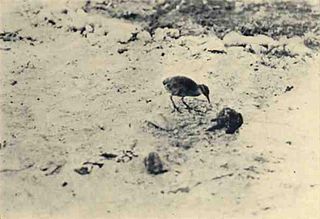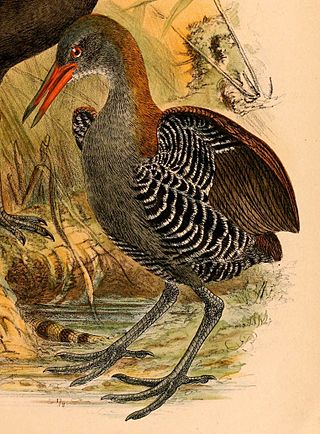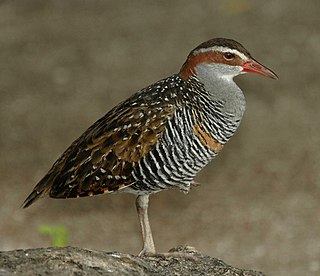
Rails are a large, cosmopolitan family of small- to medium-sized terrestrial and/or semi-amphibious birds. The family exhibits considerable diversity in its forms, and includes such ubiquitous species as the crakes, coots, and gallinule; other rail species are extremely rare or endangered. Many are associated with wetland habitats, some being semi-aquatic like waterfowl, but many more are wading birds or shorebirds. The ideal rail habitats are marsh areas, including rice paddies, and flooded fields or open forest. They are especially fond of dense vegetation for nesting. The rail family is found in every terrestrial habitat with the exception of dry desert, polar or freezing regions, and alpine areas. Members of Rallidae occur on every continent except Antarctica. Numerous unique island species are known.

The Inaccessible Island rail is a small bird species of the rail family, Rallidae. Endemic to Inaccessible Island in the Tristan Archipelago in the isolated south Atlantic, it is the smallest extant flightless bird in the world. The species was formally described by physician Percy Lowe in 1923 but had first come to the attention of scientists 50 years earlier. The Inaccessible Island rail's taxonomic affinities and origin were a long-standing mystery; in 2018 its closest relative was identified as the South American dot-winged crake, and it was decided that both species are best classified in the genus Laterallus.
The Calayan rail is a flightless bird of the rail, moorhen, and coot family (Rallidae) that inhabits Calayan Island in the Philippines. It is the only member of the genus Aptenorallus. Though well known to natives of the island as the "piding", it was first observed by ornithologist Carmela Española in May 2004 and the discovery was officially announced on August 16, 2004.

The extinct Wake Island rail was a flightless rail and the only native land bird on the Pacific atoll of Wake. It was found on the islands of Wake and Wilkes, and Peale, which is separated from the others by a channel of about 100 meters. It was hunted to extinction during World War II.

Gallirallus is a genus of rails that live in the Australasian-Pacific region. The genus is characterised by an ability to colonise relatively small and isolated islands and thereafter to evolve flightless forms, many of which became extinct following Polynesian settlement.

The New Caledonian rail is a large and drab flightless rail endemic to the island of New Caledonia in the Pacific. It is Critically Endangered, may have gone extinct many decades ago already, and if it still exists it is one of the least-known living bird species.

The Tahiti rail, Tahitian red-billed rail, or Pacific red-billed rail is an extinct species of rail that lived on Tahiti. It was first recorded during James Cook's second voyage around the world (1772–1775), on which it was illustrated by Georg Forster and described by Johann Reinhold Forster. No specimens have been preserved. As well as the documentation by the Forsters, there have been claims that the bird also existed on the nearby island of Mehetia. The Tahiti rail appears to have been closely related to, and perhaps derived from, the buff-banded rail, and has also been historically confused with the Tongan subspecies of that bird.

Porzana is a genus of birds in the crake and rail family, Rallidae. Its scientific name is derived from Venetian terms for small rails. The spotted crake is the type species.

The invisible rail, Wallace's rail, or drummer rail is a large flightless rail that is endemic to the island of Halmahera in Northern Maluku, Indonesia, where it inhabits impenetrable sago swamps adjacent to forests. Its plumage is predominantly dark slate-grey, and the bare skin around its eyes, the long, thick bill, and the legs are all bright red. Its call is a low drumming sound which is accompanied by wing-beating. The difficulty of seeing this shy bird in its dense habitat means that information on its behaviour is limited.

The snoring rail, also known as the Celebes rail or Platen's rail, is a large flightless rail and the only member of the genus Aramidopsis. The species is endemic to Indonesia, and it is found exclusively in dense vegetation in wet areas of Sulawesi and nearby Buton. The rail has grey underparts, a white chin, brown wings and a rufous patch on the hind-neck. The sexes are similar, but the female has a brighter neck patch and a differently coloured bill and iris. The typical call is the snoring: ee-orrrr sound that gives the bird its English name.

The genus Dryolimnas comprises birds in the rail family. The Réunion rail, a member of this genus, became extinct in the 17th century. The white-throated rail of Aldabra is the last surviving flightless bird in the western Indian Ocean. They are mostly found on Malabar Island, but can also be found on Polymnieli Island and other islands.

The Chatham Islands rail, also known as the Chatham rail is an extinct flightless species of bird in the family Rallidae. It was endemic to Chatham, Mangere and Pitt Islands, in the Chatham archipelago of New Zealand. The Chatham Islands rail was first discovered on Mangere in 1871, and 26 specimens collected there are known from museum collections. Its Māori name was "mātirakahu".

Dieffenbach's rail, known in the Moriori language as meriki or mehoriki, is an extinct flightless species of bird from the family Rallidae. It was endemic to the Chatham Islands.

The dot-winged crake is a vulnerable species of bird in subfamily Rallinae of family Rallidae, the rails, gallinules, and coots. It is found in Argentina, Brazil, Chile, and Uruguay.

The great Oʻahu rail or great Oʻahu crake is a little-known extinct bird species from Oʻahu, Hawaiʻi, attested only by a few subfossil bones. The holotype is a right tarsometatarsus found in a flooded sinkhole on the ʻEwa Plain near Barbers Point, the southwestern tip of Oʻahu.

The great Maui crake or great Maui rail is an extinct bird species from Maui, Hawaiian Islands, known only from subfossil bones. The holotype are the bones of one almost-complete skeleton, found in Auwahi Cave on the lower southern slope of Haleakalā at 1,145 m AMSL. Its first remains, however, were recovered in 1972 and/or 1974 from lower Waihoi Valley further east and less than half as far uphill.

The ʻEua rail is an extinct species of flightless bird in the Rallidae, or rail family. It was described in 2005 from subfossil bones found on the island of ʻEua, in the Kingdom of Tonga of West Polynesia.

Zapornia is a recently revalidated genus of birds in the rail family Rallidae; it was included in Porzana for much of the late 20th century. These smallish to tiny rails are found across most of the world, but are entirely absent from the Americas except as wind-blown stray birds. A number of species, and probably an even larger number of prehistorically extinct ones, are known only from small Pacific islands; several of these lost the ability to fly in the absence of terrestrial predators. They are somewhat less aquatic than Porzana proper, inhabiting the edges of wetlands, reedbelts, but also drier grass- and shrubland and in some cases open forest.

Hypotaenidia is a genus of birds in the family Rallidae. The genus is considered separate by the IOC and IUCN, while The Clements Checklist of Birds of the World / eBird consider the species to be part of Gallirallus. Since the mid-19th century, when these rather terrestrial birds were recognized to form a genus distinct from the decidedly aquatic Rallus, the validity of Hypotaenidia has been disputed.


















